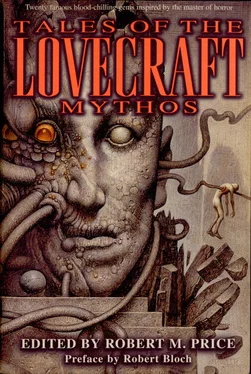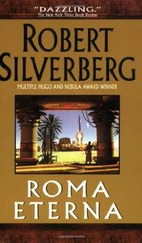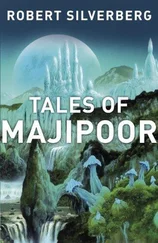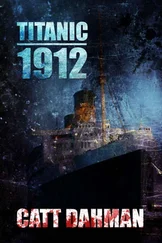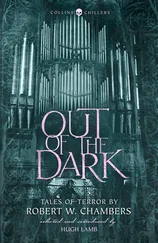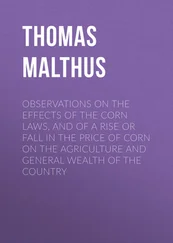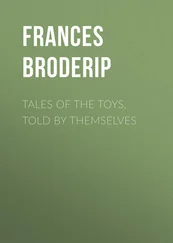So here you will find the truth that had hitherto been mercifully cloaked beneath the mystifying names Abhoth, Atlach-Nacha, Unter Zee Kulten, Hydrophinnae, the Eltdown Shards , ’Umr at-Tawil, Lloigor, Zhar, the Tcho-Tcho people, Ithaqua, Iod, Vorvadoss, Zuchequan, the Chronicle of Nath , and others. Better bring along your Elder Sign.
A few notes anent a few of the stories. Most readers will know that Lovecraft penned “The Haunter of the Dark” as a sequel to Robert Bloch’s “The Shambler from the Stars,” and that Bloch wrote another installment, some years later, called “The Shadow from the Steeple.” But the sharp-eyed reader will notice that Bloch’s earlier tale “Fane of the Black Pharaoh” ( Weird Tales , December, 1937) is in a real sense an earlier sequel to “The Haunter of the Dark,” as it develops Lovecraft’s evocative hint, dropped in that tale, about some abominable deed wrought by the Pharaoh Nephren-Ka which caused his name to be stricken thereafter from all Egyptian stelae.
August Derleth, as we know by now, was one of the great architects of the expanding Mythos (in this connection one recalls the references in several of his tales to old mansions whose original ground plans could no longer be discerned for the profusion of extra wings and rooms added over the course of generations). He appropriated for the Mythos the legendary Wendigo as fictionalized by Algernon Blackwood in his famous story “The Wendigo.” Derleth’s Ithaqua the Wind-Walker figures in many of his stories and has come into new prominence in some of the novels of Brian Lumley. Yet the stories (“The Thing That Walked on the Wind” and “Ithaqua”) in which the Mythos version of the Wendigo debuts have lain unreprinted for so long that few readers will have seen them.
Derleth’s and Schorer’s “The Lair of the Star-Spawn” is another of the pivotal stories in the evolution of the Mythos. In it we see for the first time Derleth’s version of the “Elder Gods versus Old Ones” contest, though Derleth is still experimenting with nomenclature.
If the ending seems to you far too redolent of the Derleth Mythos attacked by Mosig, what with its celestial deliverance, just recall the bolts of lightning that shoot down from the heavens to dispatch the monsters at the climaxes of “The Dunwich Horror” and “The Haunter of the Dark.” By the way, Lovecraft himself suggested the title for the tale to his correspondent Derleth and later referred to its events in “The Horror in the Museum.”
I have included two tales by Robert E. Howard, the famous creator of Pike Bearfield. One will not be unfamiliar to you, “The Thing on the Roof.” I would rank this as number two behind “The Black Stone” among Howard’s best efforts at Mythos fiction. In terms of the lore it presents it runs parallel to “The Black Stone” (which was of course included in Tales of the Cthulhu Mythos ), providing various data concerning Von Junzt’s Die Unaussprechlichen Kulten . (May I point out that the initial article die must have stood in Von Junzt’s original, since without it the title would read Unaussprechliche Kulten?) For Howard’s references to his own Old One Gol-Goroth, you may consult his tales “The Gods of Bal-Sagoth” and “The Children of the Night.”
The second Howard story, “The Fire of Asshurbanipal,” is rather less well known, though not infrequently reprinted. However, what you will read here is Howard’s original version, previously published only in the Spring 1972 issue of The Howard Collector. As you will see, though this version is a tale of Oriental adventure, not of supernatural horror, it is nonetheless a tale of the Lovecraft Mythos, illustrating a crucial fact about the lore of Lovecraft: the Old Gent himself treated his “artificial mythology” as a fund of atmospheric mood generators, not as the main spectacle on stage. Howard here follows this Lovecraftian prototype.
With Richard Searight’s “The Warder of Knowledge,” we have a special treat: a story that Lovecraft read in manuscript, but which was never published — until now. Searight, you will remember, had created the Eltdown Shards , cited in his story “The Sealed Casket,” and used to good effect subsequently by HPL in “The Challenge from Beyond” and other stories. Interestingly, Lovecraft and Searight were simultaneously developing the concept of the Shards in different directions, as can be seen from “The Warder of Knowledge.” Of it Lovecraft said in a November 4, 1935, letter to Searight, “I like the story exceedingly, & hope you will not let [ Weird Tales editor Farnsworth] Wright’s rejection discourage you…. The references to the Eltdown Shards are fascinating — but woe is me! I’ve given a lot of dope in that composite story [the round-robin “The Challenge from Beyond”] which conflicts directly with the true facts as here revealed!.. I also fear that I described the shards in a conflicting way. Oh, well — in sober truth relatively few people will ever see the composite yarn anyhow.” Ah, the ironies of history.
Bertram Russell’s “The Scourge of B’Moth,” Mearle Prout’s “The House of the Worm,” and C. Hall Thompson’s “Spawn of the Green Abyss” are a set of stories which do not bear all the customary Mythos touches, but which are significantly influenced by Lovecraft’s seminal tale “The Call of Cthulhu.” In Russell’s tale the scholarly protagonists are puzzled at the outlandish name of the monster B’Moth, but it turns out to be a contraction of the name of the Bible’s primeval sea titan Behemoth. The name itself reveals its owner as a cousin of Great Cthulhu.
“The House of the Worm” caught Lovecraft’s attention when it first appeared in Weird Tales (October, 1933). In a letter to Clark Ashton Smith he dubbed it one of the high points of the issue: “[Mearle Prout] is a newcomer, but to me his story seems to have a singularly authentic quality despite certain touches of naivete. It has a certain atmosphere and sense of brooding evil — things which most pulp contributors totally lack” (unpublished letter of October 3, 1933). What HPL did not remark upon was the thinly veiled opening lines of his own “The Call of Cthulhu,” which Prout appropriated almost verbatim for his later tale! You will have no difficulty recognizing them.
By the way, part of the tell-tale passage is missing in the only anthology appearances of the tale that I am aware of. The resurrected text has been abridged at many other points as well. But here you will see the complete text of “The House of the Worm,” rescued from obscurity at last.
“Spawn of the Green Abyss” partakes about equally of “The Call of Cthulhu” and “The Shadow over Innsmouth.” This is one of four horror tales Thompson wrote for Weird Tales , one of the others (“The Will of Claude Asshur”) also bearing clear marks of Lovecraft’s influence. But the story goes that August Derleth intimidated Thompson into dropping the Lovecraft pastiche hobby, apparently because Thompson was working Derleth’s side of the street (and selling a better product).
“The Abyss” by Robert W. Lowndes has appeared more than once since its first publication in the February, 1941, issue of Stirring Science Stories . But all the reprints have featured an updated, revised version. Though we may trust the author’s judgment and respect his decision to improve his work, we are pleased to satisfy your antiquarian curiosity by presenting the original 1941 version, in keeping with the pulp era focus of this book.
Carl Jacobi’s “The Aquarium” is another Derleth casualty. At Derleth’s request Jacobi wrote the tale for inclusion in Dark Mind, Dark Heart (1962), but he wrote it with certain Mythos references that Derleth promptly axed. Derleth had much more of a protective attitude toward things Lovecraftian than Lovecraft himself ever had! One may only guess that Derleth did not care for Jacobi’s independent variations on items of Mythos lore and wanted to keep things orthodox! (For the same reason, Lin Carter once remarked that, despite his zeal to incorporate data from all previous Mythos tales, he could never figure out what to do with the unorthodox reinterpretations in Henry Hasse’s “The Guardian of the Book,” also included in this volume.) The original version of “The Aquarium” appears here. From it derive, as you will see, Brian Lumley’s many later references to books of arcane seabottom lore such as Unter Zee Kulten , Jacobi’s mad creations.
Читать дальше
